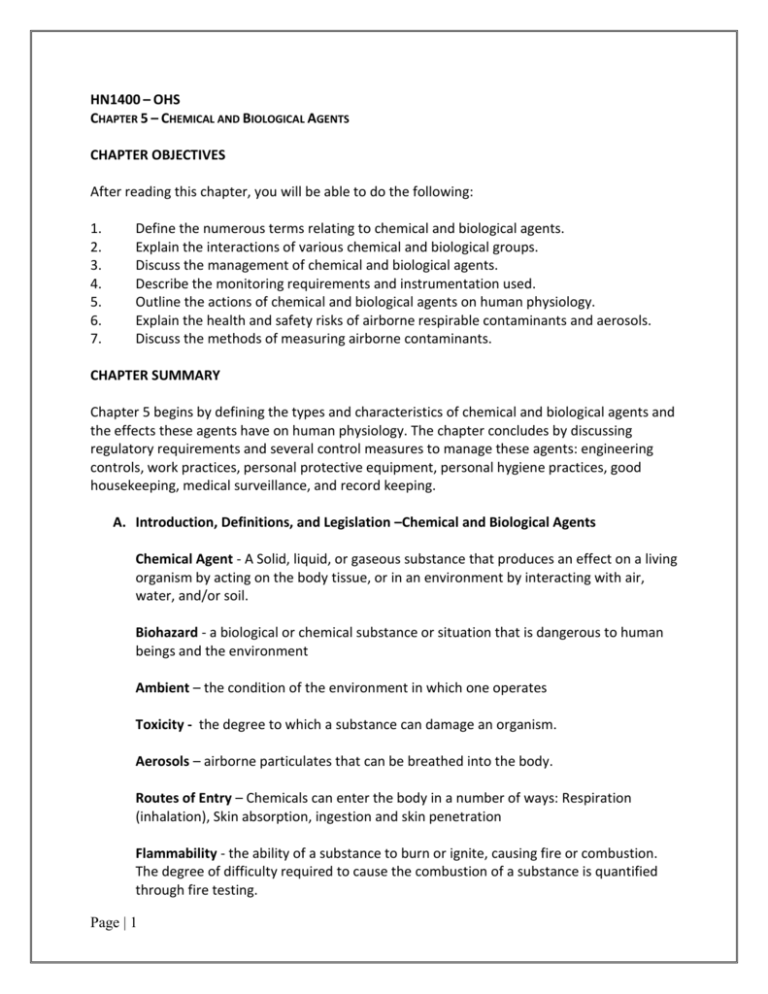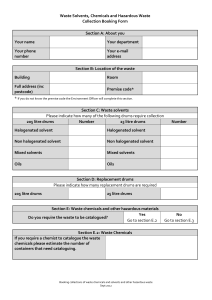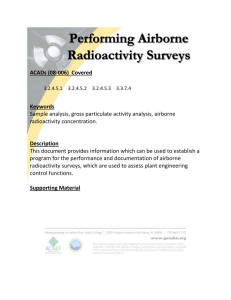Chapter 5 - Chemical and Biological Agents
advertisement

HN1400 – OHS CHAPTER 5 – CHEMICAL AND BIOLOGICAL AGENTS CHAPTER OBJECTIVES After reading this chapter, you will be able to do the following: 1. 2. 3. 4. 5. 6. 7. Define the numerous terms relating to chemical and biological agents. Explain the interactions of various chemical and biological groups. Discuss the management of chemical and biological agents. Describe the monitoring requirements and instrumentation used. Outline the actions of chemical and biological agents on human physiology. Explain the health and safety risks of airborne respirable contaminants and aerosols. Discuss the methods of measuring airborne contaminants. CHAPTER SUMMARY Chapter 5 begins by defining the types and characteristics of chemical and biological agents and the effects these agents have on human physiology. The chapter concludes by discussing regulatory requirements and several control measures to manage these agents: engineering controls, work practices, personal protective equipment, personal hygiene practices, good housekeeping, medical surveillance, and record keeping. A. Introduction, Definitions, and Legislation –Chemical and Biological Agents Chemical Agent - A Solid, liquid, or gaseous substance that produces an effect on a living organism by acting on the body tissue, or in an environment by interacting with air, water, and/or soil. Biohazard - a biological or chemical substance or situation that is dangerous to human beings and the environment Ambient – the condition of the environment in which one operates Toxicity - the degree to which a substance can damage an organism. Aerosols – airborne particulates that can be breathed into the body. Routes of Entry – Chemicals can enter the body in a number of ways: Respiration (inhalation), Skin absorption, ingestion and skin penetration Flammability - the ability of a substance to burn or ignite, causing fire or combustion. The degree of difficulty required to cause the combustion of a substance is quantified through fire testing. Page | 1 Reactivity - the tendency of a substance to undergo chemical reaction, either by itself or with other materials, and to release energy. Concentration - the ratio of the mass or volume of a solute to the mass or volume of the solution or solvent. Exposure time – the amount of time a person can safely be exposed to a harmful chemical without any adverse effects Solvents - A solvent is a substance that dissolves a solute (a chemically different liquid, solid or gas), resulting in a solution. A solvent is usually a liquid but can also be a solid or a gas. Solvents are the most prevalent of products that we use both at work and at home. Solvents can be organic (carbon based) and inorganic solvents B. Chemical Agents Chemical agents are hazards that are created by the one or any combination of a chemicals and their reactions Biological agents are hazards are biological (living - mold, fungus etc.) 80% of all Occupational illnesses are caused by chemicals The level of hazard is measured by its Toxicity For your consideration: Consider the typical office setting. What types of chemical hazards might office workers be exposed to? C. Types of Contaminants a. Dust is an airborne respirable particulate (that is solid particles generated by mechanical means (that may occur during office renovations involving sanding, or from laser printer toner. Office equipment such as photocopiers, computers, fax machines, laser printers, and ink/bubble jet printers may have ozone and hydrocarbon emissions. These must be labelled on MSDSs. b. Fumes are airborne respirable particulate formed by the evaporation of solid materials, such as automobile exhaust, that may enter through the intake of air from indoor garages. c. Smoke is an airborne respirable particulate originating from the products of combustion, such as second hand tobacco smoke. d. Mist is an airborne respirable particulate in the form of liquid droplets generated by condensation from the gas state, such as hair spray, spray perfume or other personal care products. e. Vapour is an airborne respirable particulate in a gaseous form of any substances that are normally in the solid or liquid state at room temperature and pressure, such as multi purpose correction fluids, glue, felt markers paints, lacquers, varnishes, drapes and carpets. Page | 2 f. Gas is an airborne respirable particulate that is one of the three states of matter where temperature is above the boiling point, such as elevated levels of carbon dioxide in small workspaces. g. Liquid can come in contact with the skin and/or eyes through chemical splashes or spills such as office, lunchroom, or bathroom cleaning solvents D. Toxicology and Routes of Entry In order for a chemical to become hazardous to a person's health, it must first contact or enter the body and the chemical must have some biological effect on the body. There are four major routes: a. Inhalation (breathing) - Contaminated air in the workplace can be inhaled. Air is drawn through the mouth and nose and then into the lungs. An average person will breathe in and out about 12 times a minute. Each of the 12 inhalations brings in about 500 mL of air, corresponding to 6 litres of air per minute, together with any contaminants that the air contains. b. Skin contact - The skin is the second most common route by which occupational chemicals enter the body. c. Digestive system (ingestion or eating)- Chemicals can enter the stomach either by swallowing contaminated mucus which has been expelled from the lungs, or by eating and drinking contaminated food. Food and drink are most frequently contaminated by contact with unwashed hands, gloves or clothing, or by being left exposed in the workplace. d. Injection/Penetration – Chemicals enter the body through wounds. E. Control of Exposures a. Administrative Controls – Education, training, regulations, & policies b. Personal Protective Equipment – Safety gear c. Personal Hygiene practices – hand washing etc. d. Medical Monitoring – Checking employees for signs of illness. Page | 3








